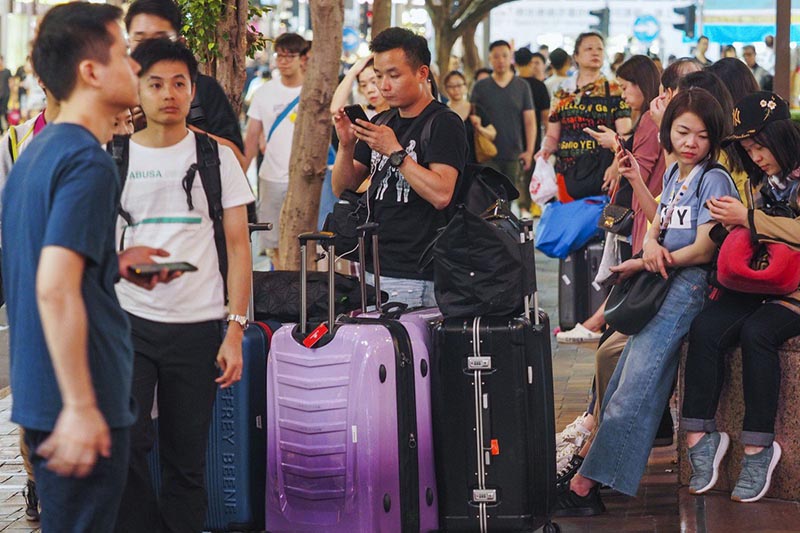[Analytics] What if mainland Chinese tourists stop coming in Hong Kong?

Tourists outside Times Square in Causeway Bay. Photo: Martin Chan
Number of travellers visiting the city continues to rise, but with nearly four in five from the mainland, local industry fears the consequences of overreliance. Kanis Leung specially for the South China Morning Post.
Hong Kong attracted a record 65.1 million visitors in 2018, with nearly four in five coming from mainland China.
The 51 million mainland visitors were a far cry from the 8.47 million in 2003, when Beijing first allowed mainland residents from designated cities to visit Hong Kong on their own under the Closer Economic Partnership Arrangement.
The massive influx has raised questions for the tourism industry, chief among them being what happens if mainlanders stop coming.
“The risk is that once the mainland faces a problem, it will affect Hong Kong directly. When the mainland sneezes, we will get sick,” said economist Andy Kwan Cheuk-chiu, director of the ACE Centre for Business and Economic Research.
But he noted that a recent slowing of China’s economy had little impact on the city’s tourism figures, because mainland tourists liked coming to Hong Kong, even if they might be spending less on their holidays than during more prosperous times.
Mainlanders have massively outnumbered other visitors despite efforts by the city to attract tourists from elsewhere.
Last year, the Hong Kong Tourism Board devoted 70 per cent of its HK$223 million promotional budget to luring non-mainland visitors, yet their numbers edged up by a mere 0.6 per cent from 2017, to 14.1 million.
Taiwan succeeded in attracting overseas visitors from alternative markets last year, after its number of mainland visitors shrank in the wake of weakening cross-strait ties.
It drew a record 11 million in 2018, thanks to a sharp increase from 18 countries targeted by its New Southbound Policy, which included Southeast Asia as well as India, Australia and New Zealand.
It is now easier for people from Cambodia, India, Indonesia, Laos, Myanmar and Vietnam to visit Taiwan, as they can apply for visas online and free of charge, without having to provide proof of income.
Tourism lawmaker Yiu Si-wing did not think Hong Kong could do the same. He said that, aside from its lower hotel prices, Taiwan’s homestay culture and varied attractions were big draws.
China’s outbound tourism boom and AI are powerful drivers of travel technology and tailored trips
“For Hong Kong, there are not many new ideas or offerings to give people a feeling of having a relaxing holiday. It’s more of a metropolitan style,” Yiu said.
Others felt Hong Kong could do more to develop new markets and find ways to entice visitors.
Brian King, associate dean of Polytechnic University’s School of Hotel and Tourism Management, saw potential in promoting links with Asean countries, a big market of more than 640 million.
He suggested developing more Muslim-friendly activities to cater to the growing numbers of affluent Muslim travellers. The potential of “halal travel” is being recognised internationally, as countries with large Muslim populations, such as Indonesia and Malaysia, have a growing number of holidaymakers eager to try new destinations.
King also saw potential in creating more travel packages that exploit the potential of the “Greater Bay Area”, which refers to Hong Kong, Macau and nine Guangdong cities that are part of Beijing’s blueprint to create an economic powerhouse to rival Silicon Valley.
Hong Kong could benefit from collaboration with other cities to package the bay area as a travel destination, he said.
Entrepreneur Allan Zeman, who developed the Lan Kwai Fong nightlife area, said Hong Kong could draw more visitors by selling culture, adding that he did not just mean the multibillion-dollar West Kowloon Cultural District.
He said each of the city’s 18 districts had a unique personality that could be showcased.
“There should be an overall plan to develop the districts with their own history and really make them exciting,” he said.
One example of this he cited was the Tai Kwun heritage and cultural centre in Central. Once a police station, it now draws visitors who get to see the old prison cells and watch arts performances.
Ester van Steekelenburg, director and founder of iDiscover App&Map, which creates authentic neighbourhood guides, said there was a growing market of independent travellers seeking to experience how locals live and find hidden places.
The Hong Kong neighbourhood guides developed by her team together with local residents showcase the stories of various districts, from bustling Wan Chai to Aberdeen, home to boatpeople.
She saw great potential in showcasing these types of attractions to draw these independent travellers, who are often young and culturally aware.
“It’s a very big market,” she said.